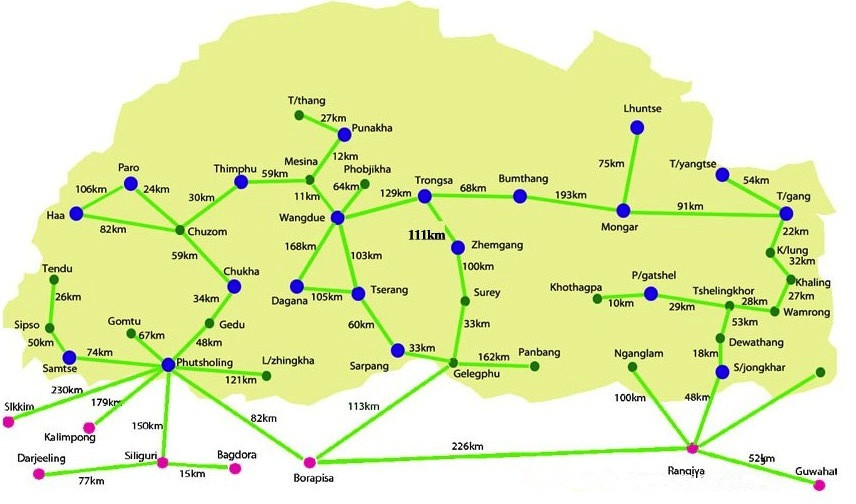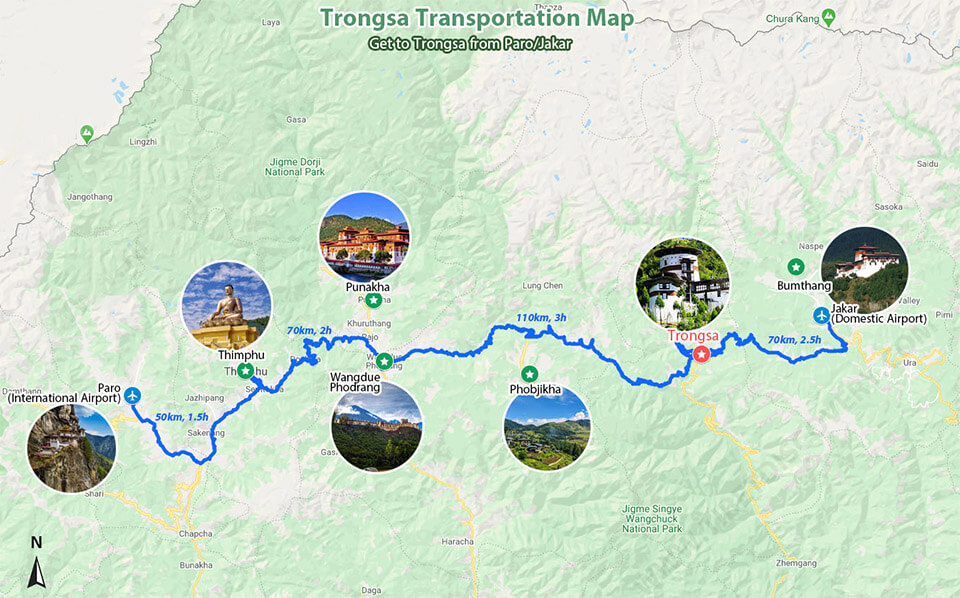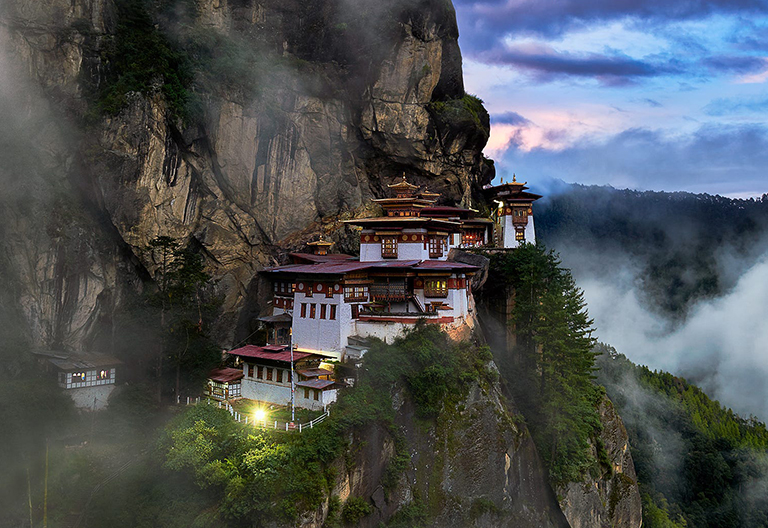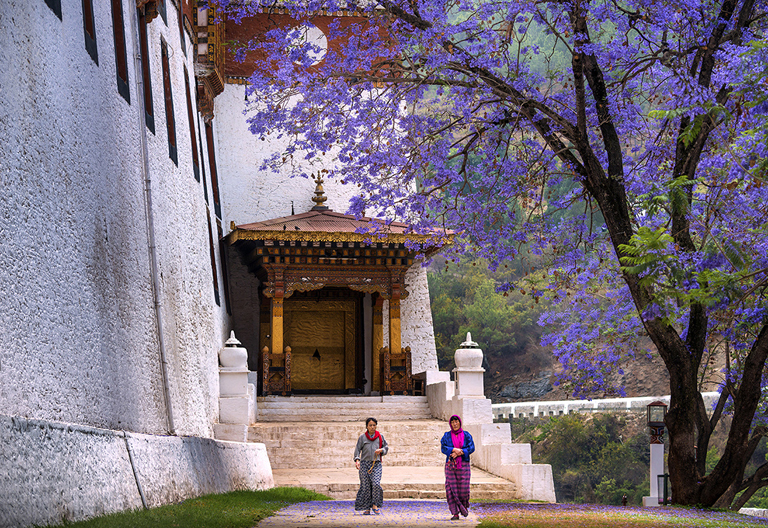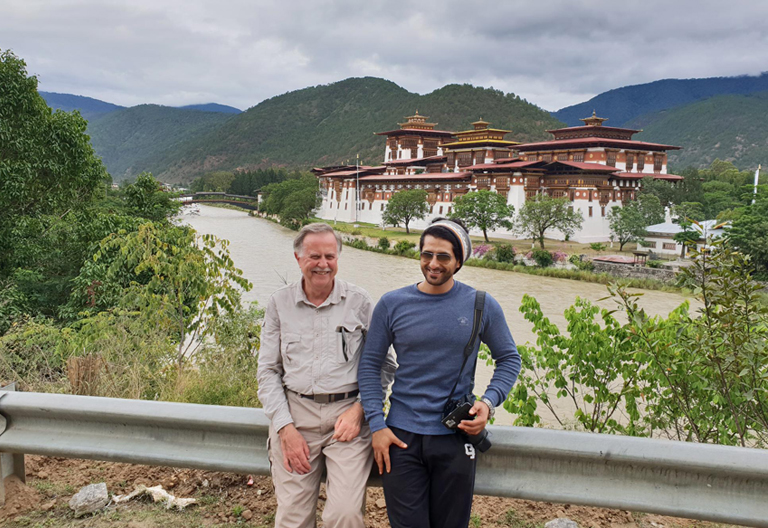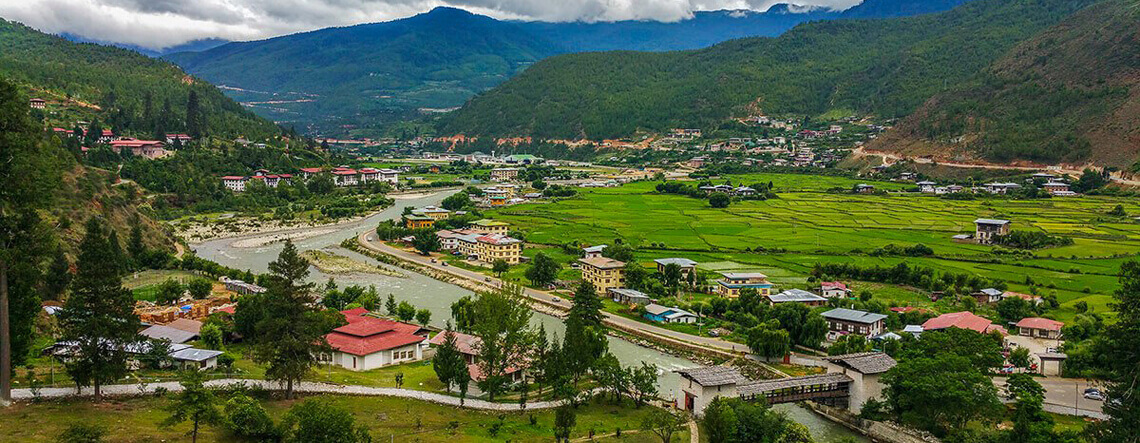
Trongsa Bhutan Travel Gudie - Sightseeing, Transfer, Hotel, Weather
Located in central Bhutan, surrounded by deep valleys and amazing views, Trongsa is a small but crucial town that had controlled the trade of the whole country, linking the west and the east, due to its strategic position. Driving to the east, you can reach Jakar and Trashiyangtse with beautiful Bumthang on your way; back to the west, you will pass through Phobjikha Valley, Wangdue Phodrang, and Punakha and arrive in the capital area of Thimphu and Paro.
Trongsa - Strategic Junction in the Middle of Bhutan & Royal Family Historical Site
Trongsa is attractive and you can finish most attractions in the town on foot. The Trongsa Dzong, the must-visit site of Trongsa, built in 1644, has been witnessing the rise and development of the royal Wangchuck family since the era of the father of the first King of Bhutan. Not afar away from Trongsa Dzong, the Trongsa Ta Dzong, a watchtower which used to guard the Dzong has been converted into an impressive museum for visitors to learn about the history of the kingdom.
Top Places to Visit in Trongsa
Located in central Bhutan, Trongsa is an important hilly town where the royal family of Bhutan originated. Here, you can trace the imperial history by visiting the watchtower Museum, Trongsa Ta Dzong, the birth palace of the King, Thruepang Palace, the winter palace, Kuenga Rabten, as well as having a wonderful Tshechu Festival in winter...
-
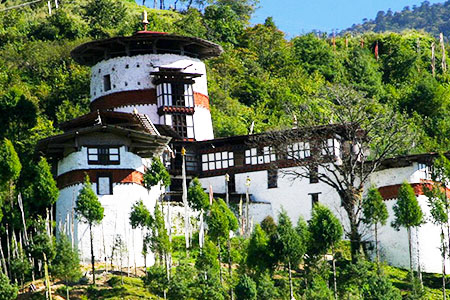
-
Tower of Trongsa Museum
Type: Sacred & Religious Sites
Recommended Length of Visit: 1~2 hours
Trongsa Ta Dzong, the watchtower, is a must-visit site in Trongsa. Standing atop the Dzong, it was built in 1652 by the first governor of Trongsa to guard it against rebellion, with four observation points shaped like Tiger, Lion, Garuda, and Dragon. Upward to visit Ta Dzong, you can see a shrine to King Gesar of Ling, and two Lhakhangs are inside. After its renovation by an Austrian team, this watch tower turns a museum. It displays various treasures on Buddhism and the history of the royal family.
-

-
Trongsa Dzong
Type: Nature & Wildlife Areas, Valleys
Recommended Length of Visit: half day
Trongsa Dzong has a long history. Its first construction can be dated back to 1648, carried out by Ngagi Wangchuck. In 1897, the Dzong was severely damaged in the earthquake, and a lot of repairing works had been done by the penlop (“governor”) of Trongsa, Jigme Namgyal, the father of the first king of Bhutan. Later, the first and second kings ruled over the country from here. The structure of the Dzong consists of many levels with fine existing decorations designed during the rule of the first king.
-

-
Chendebji Chorten
Type: Sacred & Religious Sites, Monastery
Recommended Length of Visit: 1~2 hours
On the way to Trongsa and about 2 km away from Chendebji Village by the river confluence stands the Chendebji Chorten. Built by Lama Zhida in the 18th century, it is a Nepalese styled chorten like a small version of Swayambhunath Stupa. Two eyes were painted on the white chorten which is believed to suppress the evil spirit in this area. About 500m away from the chorten is Chendebji Resort where you can have a short stay and have local meals in a comfortable setting.
-

-
Thruepang Palace
Type: Sacred & Religious Sites, Monastery
Recommended Length of Visit: 1~2 hours
To the north of the Trongsa Ta Dzong Museum is Thruepang Palace. The tiny palace is the birth palace of King Jigme Dorji Wangchuck where he spent his childhood since 1928 and it is also a winter residence of the 1st King. The two-storied palace is very simple but meaningful to the royal family and it is closed to the visitors. Seen afar, you can still tell the traditional Bhutanese architectures. Even you can not have a visit inside it, there is a popular vegetable weekend market near the palace to buy some fresh specialties.
-

-
Kuenga Rabten Palace
Type: Sacred & Religious Sites, Monastery
Recommended Length of Visit: 1~2 hours
Located in the south and about 23km away from Trongsa, Kuenga Rabten Palace is the winter palace of the second king of Bhutan,Jigme Wangchuck. Driving from Trongsa to Kuenga Rabten, you will pass through several waterfalls and beautiful rice terraces. It is open to visitors. The first floor of the U-shaped building was used to store food and the second was for royal attendants and the army. The third used to be the private chapel for the king and queen, housing statues of the Buddha and Guru Rinpoche. Now, it has been converted into a library.
-

-
Trongsa Tshechu Festival
Type: Sacred & Religious Sites, Monastery
Recommended Length of Visit: 1~2 hours
The Trongsa tshechu one of the oldest and least-visited tshechus in Bhutan. It is believed that tshechus in other parts of Bhutan was spread from Trongsa Dzong. It is a cheerful festival to pray for the happiness and harvest of the coming seasons and celebrate the Birth Anniversary of Guru Rimpoche. According to the Bhutanese calendar, it usually falls into December or January. All the chams/dances are just like regular tshechu of other Dzongkhags. The festival lasts for 3 days and on the last day, a Thongdrol (giant Thangka) will be unfurled.
How to Get to Trongsa
-
Trongsa is a small town and you can easily get around and visit most attractions there on foot. Currently, there is no airport and railway located in Trongsa. The only international airport to Trongsa is Paro airport and the closest domestic airport is Jakar airport. Hence, visitors are planning to visit Trongsa can fly to Paro or Jakar first and then drive there.
Paro to Trongsa - Trongsa is located to the east of Paro, about 240km, 6.5 hours by car. If you go straight to Trongsa from Paro, you will pass Thimphu, the capital of Bhutan, after about 1.5 hour’s ride and continue driving eastward to Punakha in central north Bhutan, and then Wangdue Phodrang, and finally reach Trongsa.
Jakar to Trongsa - Trongsa is located to the west of Jakar, about 70km, 2.5 hours by car. The domestic flights from Paro to Jakar is very limited. If you go straight to Jakar from Trongsa, you will pass the beautiful Zungney and Yotong La and get to Trongsa.
Best Time to Visit Wangdue Phodrang
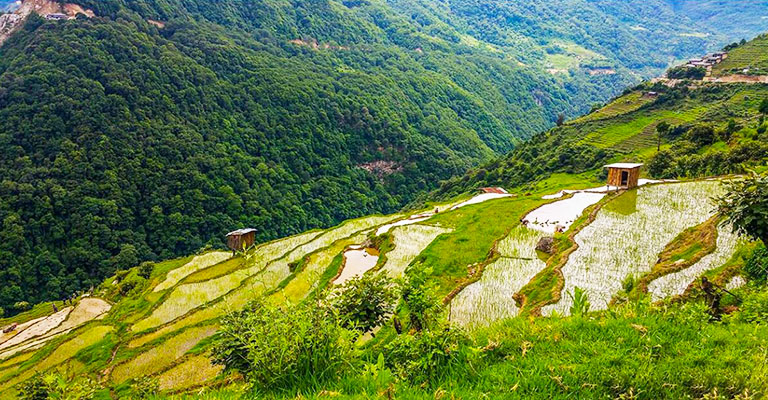
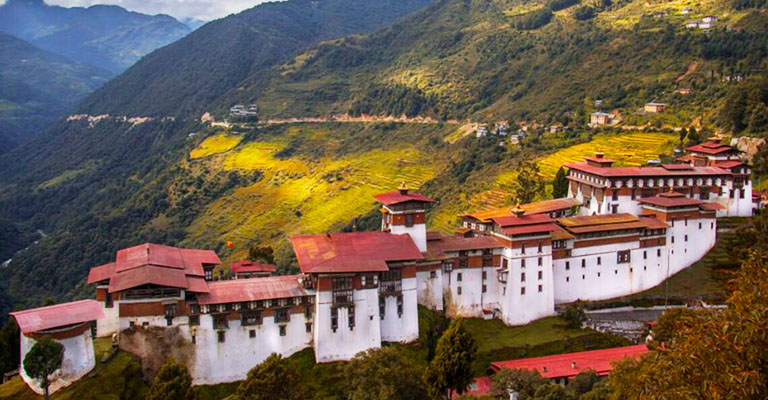
-
Located in Punakha valley with an average elevation of 2,200 meters (7,200 ft) and influenced by the south Indian Ocean, Trongsa is not hot all year round. The average temperatures in the daytime and night at Trongsa vary greatly. Even the warmest time in the average temperature of July is around 55.9°F (13.3°C) with temperatures rarely dropping below 41.8°F (5.4°C) at night. Over the year, the temperature typically varies from 29°F (-2°C) to 70°F (21°C) and is rarely below 22°F (-6°C) or above 75°F (24°C).
Considering humidity, except for the summer, Trongsa has a low chance of precipitation most of the year. And the summertime from June to September brings intense rainfall and humidity which causes lots of inconveniences. However, after the monsoon is over, the temperature will be moderate and mild with a good view for hiking, and Trongsa is without exception. The best time to visit Trongsa is spring and autumn. Also, if you do not mind the coldness in winter, December and January are good months to visit to join the Trongsa Tsechu Festival.
Where to Stay in Trongsa
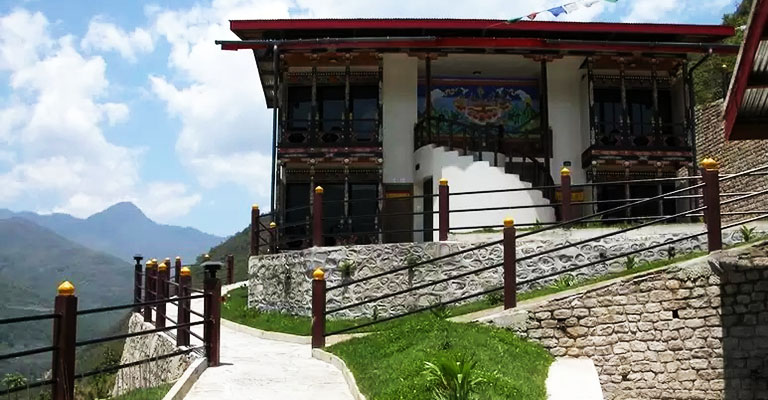
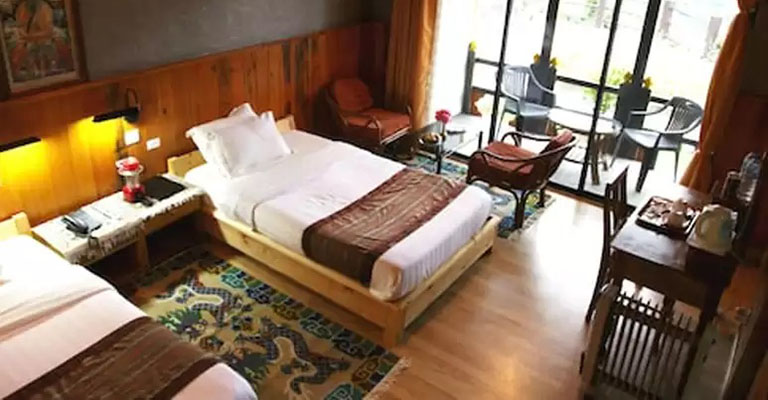
-
There are various hotels in Bhutan, ranging from fancy hotels to cozy homestays. Most of the hotels in Bhutan opening to foreign visitors are in a traditional Bhutanese style, and the accommodation fee in a 3-star hotel is already covered in your daily minimum cost in Bhutan (USD 250 per person per night in March, April, May, September, October, and November, and USD 200 per person per night in other months). If you want to upgrade your accommodation to a 4 or 5-star hotel, an extra fee may be required.
By 2020, there is only one registered hotel opening to foreign visitors in Trongsa, namely Yangkhil Resort (3-star). It is about 1.5km west of the town with 21 rooms, standing on the terraced hills facing the Dzong. All the rooms are cozy with a stunning view and nice facilities. You are recommended to stay in an upper-floor room for a better view.
Besides staying in Trongsa, not far away from Trongsa, you can have more accommodation choices in Bumthang and Phobjikha such as Chumey Nature Resort, the Village Lodge Bumthang, Odlyana Hotel, Phuntsho Chholing Lodge, etc.
Useful Bhutan Travel Notes
- 1. How to Get a Bhutan Visa
- Except Indians, Bangladeshis and Maldivians, all foreign tourists wishing to travel to Bhutan are required to obtain Bhutan Visa Clearance Letter prior to departure. It is a single-entry visa that can only be applied by licensed Bhutanese tour operator and their international partners. If you travel with us, you only need to send us a clear scanned copy of your passport for a minimum one week visa processing. Once issued, a Visa Clearance Letter will be emailed to you for taking flights to Bhutan. After arrival in Paro Airport, the immigration officer will stamp the Bhutan Visa on your passport after checking the Visa Clearance Letter. Then you can start the dream trip in the kingdom of Bhutan.
- 2. How to Plan a Bhutan Tour
- A classic Bhutan tour usually takes about 6 days involving Paro, Thimphu and Punakha. Apart from the arrival and departure days, you get 4 full days to explore the landmarks in Bhutan - three days in the towns of Paro, Thimphu and Punakha, and another day in Taktsang Monastery (Tiger’s Nest). If you want an in-depth tour to central Bhutan, you are suggested to spend extra 4 days to Bumthang via Wangdu Phodrang and Trongsa. Many travelers prefer an overland tour in Nepal, Tibet and Bhutan to discover the Himalaya Kingdoms. If time permits, you can take a one-hour flight from Bhutan to Nepal, where you can admire the medieval architectural wonders and marvelous landscape of Himalayan Peaks. After that, take an overland driving journey to the holy city Lhasa via Mount Everest, Tibet.
- 3. How to Get to Bhutan
- There are two choices to get to Bhutan – by international flights from connected Asian countries (Nepal, India, Thailand, Singapore and Bangladesh) and by overland driving from India. Since Paro is the only international airport, all the flights to Bhutan lands on Paro. Meanwhile, there are three accessible land ports connected Bhutan and India, including Phuentsholing, Samdrup Jongkhar and Gelephu. Phuentsholing is the primary one which connects Chhukha of Bhutan and West Bengal of India. From Phuentsholing, it takes about 6 hours to drive to Paro or Thimphu. The other two ports are located in central and eastern remote area of Bhutan.
- 4. Other Destinations in Bhutan
- Apart from Trongsa, there are many other destinations worthy of your visit, including Paro, Thimphu, Punakha, Phobjikha, Wangdue Phodrang, Bumthang, etc. With the only international airport, Paro is probably the first destination of your Bhutan trip. And it is also where the Taktsang Monastery - Landmark of Bhutan locates. As the capital city with natural and cultural glamour, Thimphu is a must-be-visited city in Bhutan. Its National Memorial Chorten is an important holy site. Besides, there are many interesting and significant museums and institutes to catch a view of Bhutan’s rich history and culture. Punakha has the most beautiful Dzong in Bhutan - Punakha Dzong. It looks surreal especially with the purple Jacaranda in blossom between April and June.
Most Recommended Bhutan Tour Packages
Following are some recommended Bhutan tour packages that you may be interested in. All tour packages are customizable to meet your personal requirements. You can also contact us to customize a trip if you want.
-

-

-

9 Days Bhutan In-depth Natural and Cultural Tour
Paro / Thimphu / Punakha / Phobjikha / Trongsa / Bumthang / Wangue Phodrang / Paro

